 |
|

|
 |
TABLE of CONTENTS
 |
MnDOT hosts 2016 MAASTO conference |
By Rich Kemp
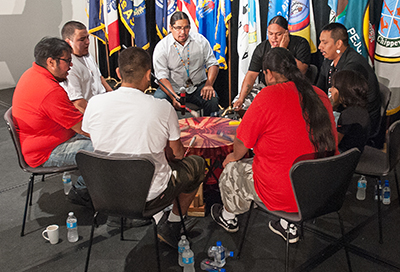
The Big Red Drum Group from the Leech Lake Band of the Ojibwe performed during the opening ceremonies of the MAASTO Conference Aug. 9. Photo by David Gonzalez |
MnDOT hosted the Mid America Association of State Transportation Officials annual conference Aug. 8-11 in Minneapolis.
“The event was a big success,” said Dan DuHamel, division business manager and special projects director. “MnDOT was able to showcase many great innovative strategies and projects to our counterparts in other states and learn from others throughout the conference.”
DuHamel led MnDOT’s conference planning efforts, which included staff throughout the agency and from the University of Minnesota. The first steps for the committee included designing a conference logo and creating a promotional video that played at the 2015 MAASTO Conference in Kansas City.
The main conference themes were:
- Measuring the impact of transportation investments
- Transportation finances and efficiencies
- Multimodal approach to project planning and programming
- Optimizing freight networks
- Diversity and inclusion
The technical program was built around the conference themes, with breakout sessions on freight, the Monarch Highway (Interstate 35 corridor), Chief Counsel’s group, environmental justice, and Human Resources.
“We preserved the traditions of the conference, but tried some new things,” said Serge Phillips, Government Relations. “With diversity and inclusion one of the main themes, we centered the opening ceremonies around our relationships with the American Indian Tribes in Minnesota.”
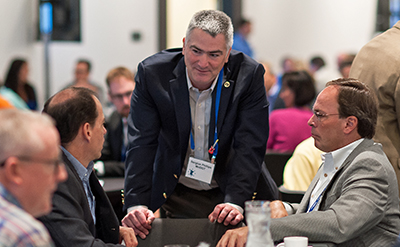
Serge Phillips, Government Relations, speaks with representatives from the Missouri Department of Transportation during the MAASTO Conference Aug. 10. Photo by David Gonzalez |
The committee set up tours of the St. Croix Crossing project and MnROAD to showcase some of MnDOT’s accomplishments.
Keynote speakers included Robert Larsen, Lower Sioux Tribal President and Minnesota Indian Affairs Council chairman; Tom Melius, U.S. Fish and Wildlife Service regional director; Bud Wright, AASHTO executive director; and James Burroughs, chief inclusion officer for the state of Minnesota.
Larsen spoke about the relationship between Minnesota state agencies and the American Indian Tribes in Minnesota. The Leech Lake Band of Ojibwe color guard presented the colors and the Big Red Drum Group performed several songs.
Melius, who is leading national efforts to conserve the monarch butterfly, discussed the Monarch Highway along the I-35 Corridor, which runs through several of the states that are part of MAASTO.
Burroughs spoke about his position created by Gov. Mark Dayton to foster a state work environment that welcomes and respects all Minnesotans.
On the final day, Commissioner Charlie Zelle, outgoing MAASTO president, passed the gavel to incoming president, Randy Blankenhorn, Illinois Department of Transportation secretary.
Besides DuHamel and Phillips, MnDOT’s conference planning team included Nancy Daubenberger, assistant commissioner, Engineering Services division; Brad Hamilton, Office of Project Management and Technical Support; Mitch Rasmussen, assistant commissioner, State Aid Division Kevin Gutknecht, Communications director; Jean Wallace, Modal Planning and Program Management assistant director; Ed Fairbanks, Tribal liaison manager; and Cindy Bellefeuille, Tribal training. They were also joined by staff from the Center for Transportation Studies and the College of Continuing Education at the University of Minnesota.
MAASTO began as the Mississippi Valley Conference of State Highway and Transportation Officials in 1907. In 2010, the organization changed its name to the Mid America Association of State Transportation Officials to better reflect the location of the member states. MAASTO consists of 10 states -- Illinois, Indiana, Iowa, Kansas, Kentucky, Michigan, Minnesota, Missouri, Ohio and Wisconsin.
|
 |
|

|
 |
TABLE of CONTENTS
 |
Stuck between a rock and…a net: Hwy 53 project crews rescue retriever |
|
By Kristi Loobeek
A runaway pup found herself in a less than ideal situation at the Hwy 53 bridge project in Virginia, Minn., on Aug. 11.
The 12-year-old Nova Scotia Duck Tolling Retriever had tried to climb down a steep rock wall and got herself stuck behind the rock netting, about 30 feet above the ground. It's unknown where the pup started her descent.
Luckily, crews from Kiewit Infastructure and Danny's Construction Company were alerted to the dog's presence after hearing falling rocks. At first glance they thought she was a fox (the workers had seen multiple foxes climb up and down the wall without issue in the past).
After unsuccessfully trying to coax the dog down the wall, a worker volunteered to go up on a man lift. The pup reportedly jumped right into the basket and was an obedient guest, sitting nicely the whole way down. The worker even brought an extra safety harness to clip the dog in the basket for extra security.
The pup, covered in iron ore dust, had a collar and I.D. tag. Within half an hour the lucky dog, Hattie (short for Hat Trick), was on her way home with her family.
In the meantime, Hattie has become somewhat of a local and national celebrity, with ABC News, People magazine and an animal news website, among other media outlets, seeking her story. On MnDOT’s Facebook page, Hattie’s tale has received 600 shares, more than 1,500 likes, and more than 75 comments.
Hattie reportedly is enjoying quiet family time.
|
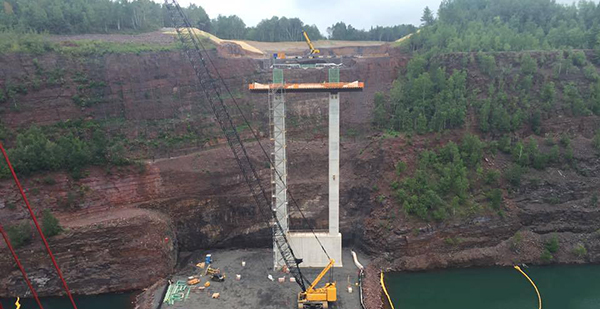
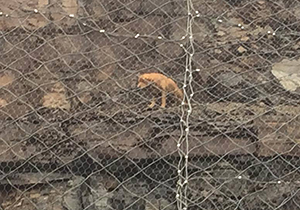 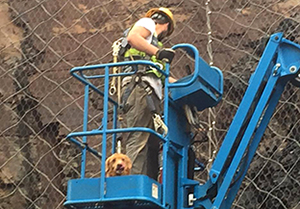
The Hwy 53 project crew rescued a dog from behind the rock netting along a steep wall of the project. Photos courtesy of Hwy 53 project |
|
 |
|

|
 |
TABLE of CONTENTS
 |
State Fair booth welcomes visitors to learn how transportation affects them now and in future |
|
By Dana Hernandez
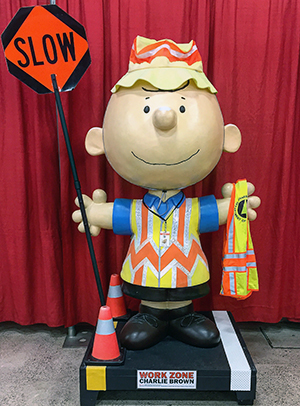
Charlie Brown is part of the MnDOT State Fair exhibit, promoting work zone safety. Photo by Dana Hernandez |
The annual Minnesota State Fair starts Aug. 25 and MnDOT again will participate during the 12-day run, through Labor Day.
Like previous years, the booth is located in the Education Building at 1372 Cosgrove St. The display celebrates the 60th anniversary of the interstate highway system and volunteers will discuss current projects such as the Hwy 53 Relocation, the need for a comprehensive transportation plan and MnDOT’s transportation funding story. Fairgoers are welcome to ask questions and pick up a 2015-2016 state highway map.
Work Zone Safety Charlie Brown is making a comeback to the State Fair booth and will be photo-ready for visitors (Charlie's last visit to MnDOT's booth was in 2003.) Social media users are encouraged to post their photos with him using the hashtag: #MnDOTattheFair.
Other engagement opportunities include samples of old and new roadway materials along with core samples showing a cross-section roadway view.
Transit Office employees will be involved in the Kick Gas exhibit at the Eco Experience building at the corner of Cosgrove Street and Randall Avenue speaking with the public about multimodal transportation. The exhibit includes MnDOT’s interactive tilt table game that uses a ball rolling down streets to find transit options.
Catch a MnDOT snowplow and the Minnesota GO mobile in the fair’s 2 p.m. parade on Monday, Aug. 29, and Thursday, Sept. 1.
For more information, check out the MnDOT State Fair website. |
 |
|

|
 |
TABLE of CONTENTS
 |
Stakeholders’ desires drive two-year rest area amenity sign pilot project |
By Dana Hernandez

Three dozen rest area signs, such as this one along Interstate 94 in the Twin Cities east metro area, are part of a two-year amenity sign pilot project MnDOT is conducting. Previous signs did not list the amenities, but simply said, “rest area” to alert motorists. Photo by Rich Kemp |
Anyone who goes on long car rides, whether for work or vacation, knows that rest areas are quite helpful. However, some motorists may not be inclined to stop because they are unaware of the variety of services offered.
Creating a larger awareness of rest stops is what jump-started MnDOT’s research into the rest area amenity sign pilot project.
In 2009, MnDOT organized a focus group to consider how to encourage motorists to take advantage of rest areas and the amenities, services and products they offer. By conducting telephone interviews and gathering input from customers, staff compiled the results into the Rest Area Amenities Study Final Report.
The report found that the signs themselves listing rest area amenities were among the top five desired amenities provided for all age groups, including commercial vehicle operators. The others from the top five include having direct access from the highway, adequate parking, flush toilets and video surveillance.
A focus group participant suggested that installation of new amenity signs in advance of rest areas would influence drivers to stop, which in turn would allow MnDOT to set better customer expectations, since not all rest areas are alike.
“Rest areas are essential safety features on the highway system that help address driver fatigue, a major cause of serious accidents,” said Rob Williams, rest area program manager. “Their basic service is crash prevention.”
The pilot project included installing 36 new amenity signs. The signs were funded by MnDOT’s Transportation Research Implementation Group and placed along Interstate 35, I-94 and Hwy 371 in July 2015. Previous signs did not list the amenities, but simply said, “rest area” to alert motorists.
The pilot project will measure the effectiveness of the new signs for two years to determine if they drew in drivers to make use of the rest areas.
Beginning November 2015, MnDOT asked travelers to take an electronic survey to see if the individual rest area signs factored into their decision to stop. Rest area water usage and vending sales data may also be used to evaluate any increase in customer use. This will continue for the duration of the project in order to measure the effectiveness.
Some survey questions included:
- Did you see any signs on the highway before exiting to this rest area describing the services offered?
- Did the services described on the signs affect your decision to stop at this rest area at all?
- How helpful was the signage to you?
MnDOT will compile answers at the end of the two-year pilot project in a new evaluation report.
Williams led the team to implement the project. He worked with Heather Lott, state signing engineer, Ken Wenkel, District 7 traffic engineer, and the Traffic Engineering Organization Signing Committee to create the design of the signs. Williams also worked with Public Engagement and Constituent Services to develop the survey questions needed to evaluate the project. Brad Lechtenberg and David Finkelson from the Sign Shop, fabricated the amenity signs and district crews installed them.
The rest area amenity project is helping promote the services offered at upcoming stops that drivers don’t know about. These services and products help create safer roads for all motorists, according to Williams.
Rest areas are classified according to what is offered, such as restrooms, picnic areas, children’s play lots, dog runs, gift shops and other features that benefit travelers.
Being able to stop on longer drives allows drivers to stretch their legs and find information, families to have lunch, and dogs to run around. These are important since “drowsy driving” is such a serious issue, according to Williams.
Rest areas also support commercial freight movements and help promote tourism.
“From my position as safety rest area program manager, from the standpoint of highway safety, anything that MnDOT can do that encourages motorists to pull off the highway to take a break from driving is a big plus in my book,” said Williams.
It has been more than eight months since the pilot project began and so far the results show that about a third of motorists who stopped at rest areas and took the survey recalled seeing the amenity signs. A third of the respondents couldn’t remember seeing the signs and the rest had not seen them. Despite this, 44 percent of motorists said that the signs influenced their decision to stop at the rest area and 68 percent found the signs helpful.
Williams is pleased with the results thus far.
“We will be eager to track this feedback over the next 16 months,” he said.
Although not specifically tied to the project, research has also found that motorists appreciate wireless Internet access and a variety of information important to traveling, such as maps and tourism information. |
 |
|

|
 |
TABLE of CONTENTS
 |
Maintenance Operations Research program fosters employees’ ideas |
|
By Sue Roe
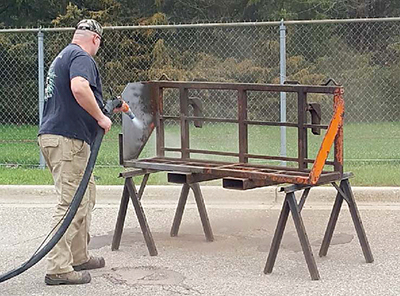
Bill Lane, Maplewood bridge crew, uses the vapor blaster to remove paint and rust. This system uses up to 70 percent less media than a typical sand blaster. Mn/DOT file photo |
Editor’s Note: This is the first of two stories about how MnDOT maintenance employees help find solutions to everyday problems.
Maintenance crew workers are natural problem-solvers. They encounter challenges in their daily work and come up with solutions.
Employees who have knowledge about existing products and practices that have the potential of improving maintenance operations can turn to the Maintenance Operations Research program that funds the testing and evaluation of the ideas.
“We look at anything that will make their jobs more efficient and create a safer work environment,” said Steven Blaufuss, statewide maintenance work zone safety coordinator, who helped with the MOR program. “We’re trying to use things already out there that are innovative, help employees be more effective and improve safety.”
The program helped the Golden Valley traffic services crew when employees needed a way to see and communicate with the driver of the traffic control truck during cone setting operations.
“We’d been looking into safer operations for setting cones since two of our employees were hit while closing a lane,” said Jeff Streeter, Metro traffic services at Golden Valley. “Last year we rented a traffic control truck and employees felt much safer setting cones. The only issue was they did not have good visual or audio contact with the driver.”
Streeter said employees wondered if there was a headset they could use, so Streeter found a wireless headset on the Internet.
“They feel much safer having them on. As soon as we got them, we were getting requests for other crews to try them out,” Streeter said.
The Metro District is evaluating the headsets for use in other maintenance operations, such as flagging, overhead sign repair and tree removal.
Blaufuss said when an employee suggests an idea, he or she becomes the “project champion” and is responsible for researching it and proposing it to the program.
He said employees also come up with ideas when they attend expos and conferences or talk with other co-workers and friends.
The program, which began in 1992, funds research projects in the areas of winter maintenance, winter material, road and bridge maintenance, roadside maintenance, equipment and tools, safety, traffic control and work zone safety.
A statewide Maintenance Operations Research committee meets monthly to review the projects if the proposal is under $15,000. If the project costs more than $15,000, the statewide New Technology, Research and Equipment Committee decides whether or not to fund it. That committee meets twice a year.
Projects are awarded based on their expected benefits/return on investment, potential for improving safety in the field, opportunity for statewide implementation and supports transportation preservation.
In fiscal years 2014 and 2015, 62 projects were funded across all districts.
“When we look at a project, it needs to be new, innovative and cutting edge technology. The program helps expedite the process of getting a new product or process out into the field,” Blaufuss said.
MnDOT’s patching operations are “light years” ahead because of employees’ funded ideas, he said.
“The program gave the opportunity to districts to experiment with other patching materials. By leveraging the money for a project that they wouldn’t have had otherwise, it helped MnDOT come leaps and bounds with using new materials for patching,” he said.
Once a district gets approval to test a product and it is deemed effective, other districts are free to adopt the idea.
Here’s some other projects that received funding from the MOR program:
- District 7 and Metro maintenance workers who used handheld flashlights to see and be seen during night-time operations now use halo lights as a hands-free alternative. The halo light attaches to a hard hat and produces a ring of light around the wearer that provides visibility in all directions up to a quarter mile away. The lights increase the efficiency and safety of night-time operations.
- The portable emulsions system is a heated emulsion storage tank designed to perform year-round patching operations without the need to build a costly heated storage shed for a conventional tank. This system can be relocated closer to job sites to reduce operating costs and improve efficiency for large scale operations. The unit also has a reverse flow pump system that prevents emulsion from running out of the hose, which helps protect the environment and keeps people and equipment clean. District 4 staff is evaluating this system.
- A heated truck bed insert uses the truck’s engine coolant to heat asphalt patching mix to a workable temperature year-round. The system allows leftover hot mix to be reheated, eliminating the need to chip out hardened mix each day. The hot patch heater, tested in District 6, reduces manpower and time needed to get the patching material hot enough to apply to the roadway. It’s also a “green” solution because it uses the engine’s own coolant to heat the mix rather than fuel. The ergonomic shoveling platform makes patching easier and safer.
- A ditching wheel, tested in District 2, has a rotary blade to clear vegetation from roadside ditches. It was tested during the winter to cut through compacted snow and ice that accumulates in ditches to help with water flow and eliminate flooding during the spring melt. The ditching wheel allows work to be completed in about half the time and with less equipment compared to using a trackhoe.
- The vapor blaster is a self-contained unit with an air compressor and water tank. This system uses up to 70 percent less media than a typical sand blaster. Crews use it to remove rust and grime from beam ends, bearings, abutments and bridge joints. It can be used for graffiti removal without damaging surfaces. Dust suppression is nearly 100 percent, so there is no need for a respirator or other special equipment. The Maplewood bridge shop is using this system.
Read about more projects from the program in the 2013-2015 research report. For more information about the program, including proposal forms, visit the MOR website.
Next issue: The Technology Transfer program takes employees’ ideas for small, in-house built devices and helps them become beneficial for maintenance operations. |
 |
|

|
 |
TABLE of CONTENTS
 |
What’s new on the web |
By Greg Ruhland

The new Transportation Asset Management System web page will help with budgeting and planning of the department’s maintenance and operations activities. |
Transportation Asset Management System
TAMS is the department's new primary work management system for signals and lighting. Future expansion will include traffic barriers, signs, drainage, pavement markings and more ancillary assets.
TAMS will improve budgeting and planning of the department’s maintenance and operations activities – helping MnDOT become more fiscally responsible in the process. It will do this by allowing MnDOT to collect data and to better understand the costs associated with these activities.
“You might remember that MAP-21, the 2012 federal surface transportation legislation, triggered the department's strategic approach to asset management,” said Tom Zimmerman, TAMS business process specialist. “With TAMS, we will be able to perform trade-off analysis and further refine the life cycle cost analysis for the Transportation Asset Management Plan.”
Zimmerman said data from TAMS will help provide more accurate predictions and estimates of future infrastructure needs identified in that plan and in Minnesota's State Highway Investment Plan.
For more details, visit the TAMS Home on iHUB. It can be found under T in the A to Z index.
New Library Materials
New Library Materials are available at www.mndot.gov/library/newlibmat.html. This issue features a new digital resource for MnDOT employees: ASTM DOT Compass Portal.
New Library Materials is a compilation of new titles and other resources added to the library collection during the previous month. If you would like to be added to the distribution list, contact Pam Gonzalez at 651-366-3749.
Previous editions of New Library Materials are available at www.mndot.gov/library/recacq-archive.html.
For other information requests, contact the Library at 651-366-3791 or email library.dot@state.mn.us, or send requests via the Ask a Librarian Web page at www.mndot.gov/library/asklibrarian.html.
|
 |
|

|
 |
TABLE of CONTENTS
 |
Agencies sustainability activities fall in-line with Lt. Governor’s initiative |
By Sue Mulvihill, deputy commissioner/chief engineer
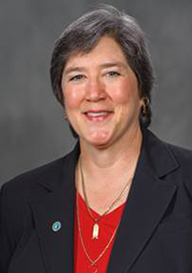
Sue Mulvihill is MnDOT's deputy commissioner and chief engineer Photo by David Gonzalez |
Lt. Gov. Tina Smith recently announced the creation of a new Office of Enterprise Sustainability. This initiative will help state of Minnesota agencies lead by example to reduce greenhouse gas emissions and water usage, increase energy efficiency and recycling, and better coordinate sustainability efforts across state government.
“Climate change is one of the greatest challenges facing Minnesota--marked by intensifying concerns regarding water scarcity, loss of pollinators and drinking water contamination,” said Smith in a recent letter to state of Minnesota commissioners. “Climate change also presents an opportunity for us to build a more resilient and sustainable state.”
MnDOT has worked on sustainability initiatives for many years, doing its part to conserve resources and help employees take advantage of sustainable and money-saving resources to minimize the effects to climate change. In February 2016, MnDOT created a Sustainable Transportation Steering Committee to provide leadership, strategic direction and management oversight for high-priority natural resource issues and agency-wide sustainability activities, including greenhouse gas mitigation and climate adaptation. As MnDOT’s deputy commissioner and chief engineer, I am serving as the executive champion for the STSC. Tim Sexton, Office of Environmental Stewardship, chairs the committee that includes representatives from MnDOT districts statewide and central office.

District 6 included solar panels in the redesign of their new headquarters building in Rochester. In addition, their maintenance facility uses geothermal for heating and cooling power. Photo by Steve Wondrasch |
The STSC identifies sustainable transportation priorities. Committee members coordinate statewide sustainability efforts and make sure that there is an agency-wide understanding of sustainable transportation policies, guidance and direction that apply to MnDOT operations and to our facilities used by the public. Some recent examples include the following:
- Renewable Energy - Districts, Office of Land Management
MnDOT is one of several state departments of transportation evaluating the costs and benefits of using solar energy to power our facilities and reduce greenhouse gas emissions by offsetting electricity use from nonrenewable sources. District 6 recently installed a 40 kWh solar array to offset a portion of the building’s annual electricity use at its new headquarters building. The Office of Land Management is also leading a research project to identify other MnDOT facilities with the high cost-benefit potential for solar.
- Sustainable Fleet Operations - Office of Maintenance
In 2016, MnDOT was accredited as a “Sustainable Fleet” by the National Association of Fleet Administrators. This is the worldwide standard for recognizing fleet improvements in air quality by reducing emissions, increasing fuel efficiency and reducing fuel use. “We have a unique opportunity to make a difference to the bottom line and positively impact our environment,” said Bob Ellingsworth, MnDOT fleet manager. “Being recognized by the NAFA Sustainable Fleet Accreditation Program, highlights all the hard work that MnDOT has done to reduce overall fuel consumption.”
- Greenhouse Gas Inventory - Office of Maintenance, Office of Environmental Stewardship
A Greenhouse Gas inventory helps business and government understand where, and how, they are releasing greenhouse gas emissions so they know where to focus greenhouse gas reduction efforts. MnDOT previously reported greenhouse gas emissions for Central Office to support multiagency reporting for the Capital Complex. This fall MnDOT will complete the first agency-wide greenhouse gas emissions inventory. MnDOT will also attempt to estimate greenhouse gas emissions from the construction of one year’s worth of projects.
- Greenhouse Gas Reduction Targets – Office of Transportation System Management
The upcoming Statewide Multimodal Transportation Plan will be the first statewide transportation plan in Minnesota to set a target for greenhouse gas emissions consistent with the Minnesota Next Generation Energy Act.
- Climate Resilience and Adaptation - Office of Transportation System Management
In 2014, MnDOT participated in an FHWA pilot project to understand highway system risk from flash flooding. The project did a districtwide vulnerability assessment in District 1 and District 6 and included two detailed case studies of culverts (District 1 – Hwy 61 on Silver Creek; District 2- Hwy 63 in Spring Valley). Future efforts will work to improve the resilience of MnDOT's facilities weather extremes.
MnDOT takes an active role, and responsibility, in making state government sustainability a priority. As a state government agency, we lead by example by reducing carbon emissions from fleet and buildings, recycling and composting programs and increasing how we manage our roadside vegetation.
MnDOT also supports a wide array of transportation options. Visit these websites for more information about resources for transit riders all across the state and maps by county of bicycle trails and bike-friendly roadways. |
 |
|
| |
|



